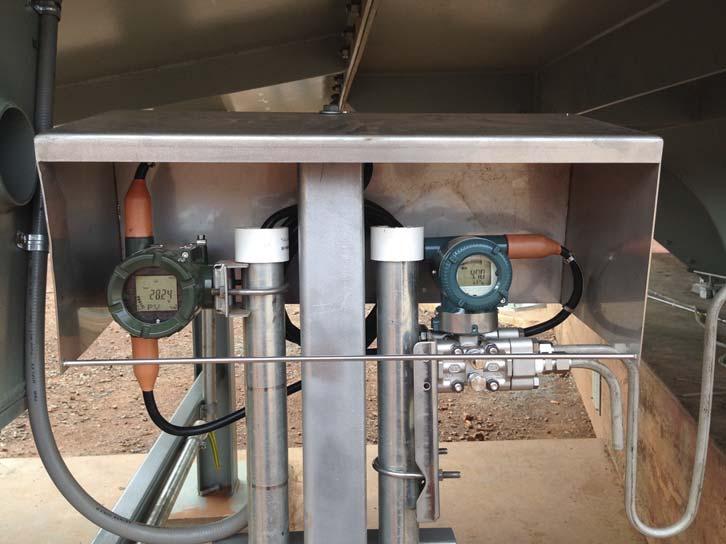
10 minute read
Modern Maintenance And Monitoring


MODERN MODERN MAINTENANCE MAINTENANCE AND MONITORING AND MONITORING
The New York Blower Company details an innovative strategy for equipment management and maintenance that leverages robust fan design in combination with advanced remote monitoring systems and IIoT technologies.
Industrial fans sustain many critical functions and sensitive processes throughout a cement plant. There are induced draft (ID) fans that supply air for fuel combustion, exhaust fans that remove gas and dust particulates, and coal mill fans that provide airflow to burn coal and eliminate gases, to name a few. These heavy-duty industrial fans are exposed to some of the most challenging operating conditions, including high temperatures, vibration, rapidly changing process conditions, heavy dust and debris accumulation, and more. Furthermore, over the life of the equipment, fan efficiency typically degrades from its original operating conditions.




Motor vibration sensors attached to the fan measure vibration velocity, as well as monitor temperature and vibration levels.
The shaft collar pressure and air temperature monitors transmit real time data with the ability to enable automatic calibration.
An Accutron fl ow sensor in the fan duct helps monitor, control, and diagnose potential problems with air fl ow.
This requires equipment motors to work harder, increasing energy consumption and power costs, and posing safety hazards if motors are running outside of the safe range.
Keeping fans within a cement plant running smoothly, safely, and efficiently is critical to avoiding costly unplanned downtime and lost production time. However, continued exposure to hot and dirty operating conditions will inevitably lead to fan wear over time, with continual maintenance costs if not provided properly.


Common types of fans and key challenges for cement plants
The following are several common fan applications within cement plants, as well as the key challenges for these fans.
Raw material conveying
Raw mill fans move raw meal through production. For these fans, the primary challenge is to avoid excessive debris build-up due to sticky dust. When these dust particles accumulate, especially in uneven patterns on the fan impeller, the fan can become imbalanced, and the system may be at risk of total failure.
Preheater and kiln fans
At the beginning of the cement production process, the raw material is dried using hot air from a kiln exhaust fan. The fans draw the air – which can reach 450˚C (842˚F) – from the kiln and into the raw mill area to preheat the material. After preheating, the material moves into the kiln, where process temperatures can be as high as 1093˚C (2000˚F). Induced draft (ID) fans supply air for fuel combustion and exhaust fans expel gas and dust particles. The primary challenges for preheater and kiln fans are the high temperatures, heavy dust loads, and the mixture of gases to which fan elements are exposed throughout the process.
Clinker cooler fans
After heating in the kiln, the raw meal becomes clinker, a solid and highly abrasive intermediary product of the cement production process that presents as particles of varied in size and shape. Fans involved in the clinker cooling process must be able to withstand the resulting abrasion
and wear from exposure to these particles. Cooling fans must also be designed with power requirements in mind, as improperly designed cooler fans can lead to high power consumption and excessive energy costs.
Coal mill fans
Coal mill fans create airflow for coal burning and gas elimination. Similar to other fans in the cement production process, coal mill fans are frequently exposed to high temperatures and dust-loaded air.
Remote monitoring advantages
There are many design approaches that can help mitigate wear, increase the overall life of the fan, and extend the time between repairs. One solution is to choose wear-resistant materials designed to withstand the rigours of the specific application, and to apply liners or overlays that protect the base material from corrosion and other forms of wear. In addition, fan manufacturers should design fans with the appropriate geometry to reduce uneven particulate build-up on the fan’s impellers.
While these tactics remain critical to high performance and high effi ciency fan design, they are ultimately preventative measures that merely slow down wear. Ruggedness alone is insuffi cient. Remote monitoring takes prevention a step further and can actually help predict and prevent the ultimate consequence of equipment failure – unplanned downtime.
To keep cement plants running as smoothly and efficiently as possible, effective fan design should be leveraged in combination with remote monitoring and IIoT technologies that can be used to optimise fan performance, identify the signs of wear early so that they can be resolved quickly, and ultimately save significant costs over the life of the fan.
What is remote monitoring?
Remote monitoring gives users insights into fan performance and equipment health in real time. It works by installing sensors at key points on the equipment to identify critical changes in performance. For example, mechanical sensors mounted to the motor shaft can measure vibrations, comparing real time vibration frequency to an established baseline. As fan bearings wear, vibration frequency increases, which is an early indicator of a mechanical problem. Particle sensors can also be used to monitor the volume of dirt and dust in the airstream. Simultaneously, current and voltage sensors continuously monitor power inputs in order to optimise energy consumption and quickly identify when fan behaviour indicates an ineffi ciency.
Remote monitoring sensors can quickly identify acute conditions that require immediate actions and monitor subtle performance changes that predict future failures so they can be prevented with proactive maintenance. This is also called predictive maintenance. Ultimately, this means that by continuously monitoring air blowing equipment, cement plants can respond to critical conditions in real time and effectively plan maintenance schedules to resolve problems before they escalate to catastrophic failure and downtime – all while optimising overall fan performance and effi ciency.
Why remote monitoring?
Over the past decade, remote condition monitoring has quickly become a popular solution to effectively manage and maintain industrial equipment. The benefits of the technology have become rapidly apparent across industries. The reasoning is because remote condition monitoring and predictive maintenance give users accurate data and visibility into the performance of their equipment at their fingertips: A powerful capability that helps users
ABB Smart Sensors monitoring system collects data on the collar temperature and pressure on fans.

make real time data-driven decisions that save costs and drive efficiency throughout the entire plant.
While remote monitoring might sound like an expensive upgrade to existing installations or as an addition to an initial fan deployment, it is actually only a minimal additional upfront cost that ultimately pays for itself by reducing the total cost of ownership (TCO) over the life of the equipment.
The following are a few practical examples of how remote condition monitoring is being used in cement plant equipment and the value it can provide for operations.
Reduce costly unplanned downtime
Downtime is expensive – especially when it is unexpected. The costs of sudden, unplanned equipment breakdown can soar to millions of dollars in lost productivity if work is stalled while staff scramble to identify and fix the problem. Remote vibration and temperature monitoring can help prevent this worst-case scenario by indicating problems early on, and by helping to quickly pinpoint and diagnose critical conditions when they do happen.
How does this work? Essentially, all industrial fans operate at a tolerable baseline level of vibration and temperature fluctuation. Some variation is normal, and isolated spikes often are not a cause for alarm. However, sustained changes to the baseline over time can be the first indication of a problem. For example, uneven dust loads on the fan impeller will gradually increase vibration, eventually resulting in premature fan wear or unexpected failure. With remote monitoring, users are alerted to the upward trend in vibration and/or temperature so that it can be investigated and resolved before it results in major damage.
To do this, vibration and temperature sensors are installed at the fan shaft and bearings to observe and interpret changes that could affect performance. If an alarm threshold is met (i.e., vibration has exceeded acceptable limits for a period of time), a text message can be sent to an operator’s phone to let them know the equipment needs to be evaluated soon. Personnel can then quickly diagnose and resolve the issue before it escalates into a bigger problem. Data can also be fed into dashboards at a command centre to map trends over time, visualise performance insights, and more.
Leverage the power of predictive maintenance
Traditional preventative maintenance plans rely on regular, scheduled maintenance to ensure smooth equipment operation. In comparison, predictive maintenance uses real time data from the equipment to reliably predict and prevent major problems that can lead to costly unplanned downtime. Predictive maintenance is also signifi cantly more accurate in capturing data compared to manual data collection methods. This is important because more accurate data enables better decisions.
Remote monitoring also allows users to track trends over time to continuously improve the effi ciency of their operations. Data can be used to measure and improve overall equipment effectiveness (OEE), which is a percentage value that represents the equipment’s total availability, performance, and production quality.
Overall, these capabilities empower users to be proactive rather than reactive in how they manage and take care of their equipment. Ultimately, by combining these technologies with robust fan design, users can achieve better effi ciency, with shutdowns only for planned maintenance.
Optimising power consumption
One last but important consideration for installing remote monitoring systems is how they can help save significant power consumption costs, one of the largest expenses associated with the operation of air blowing equipment. Remote airflow and pressure monitoring technologies provide visibility into the fan’s efficiency metrics in real time, allowing users to quickly identify when a fan is running inefficiently and using more power than normal or necessary. Personnel can then be alerted to further investigate why the fan is running inefficiently so they can resolve the problem. Because power is such a big expense, optimising fan power consumption can result in considerable long-term savings and significantly improve margins.
Conclusion
For industrial fans installed in cement plants, ‘built-to-last’ is no longer enough to support critical functions throughout the plant. To be competitive in today’s cement industry, plants must approach fan equipment with a modern strategy that combines robust design with the latest remote monitoring and predictive maintenance technologies. This not only improves the reliability and efficiency of equipment, but also helps plants maximise production and reduce the total cost of ownership (TCO) by optimising ongoing maintenance and power costs. A knowledgeable and experienced air blowing equipment manufacturer can help customise the most reliable, cost-effective solution possible for any application.

AD INDEX AD INDEX

ABC www.abc.org.uk
ATD Abbausysteme GmbH www.atd-cardox.com
Axians www.axians-ias.com
Bosch Rexroth www.hagglunds.com
Bowman Split Bearings www.bowmansplitbearings.com
Brokk & Bricking Solutions www.brokk.com www.brickingsolutions.com
Christian Pfeiffer www.christianpfeiffer.com
Dalmia-OCL www.dalmiaocl.com
DALOG www.dalog.net
Flexco www.fl exco.com
HEKO www.heko.com
HGH Infrared Systems www.hgh-infrared.com
Howden www.howden.com
InterCem www.intercem.de
14
35
13
57
27
24 – 25
31
61
IFC
04
02
65
51
69
KHD Humboldt Wedag www.khd.com
LUBRILOG www.lubrilog.com
Maerz www.maerz.com
MMD www.mmdsizers.com
NAK Kiln Service www.nak-kiln.com
New York Blower Company www.nyb.com
REFKO Feuerfest GmbH www.refko.de
Stela Laxhuber GmbH www.stela.de
thyssenkrupp Industrial Solutions www.thyssenkrupp.com
Unitherm Cemcon www.unitherm.at
WestRock www.westrock.com
WCT2021 www.worldcement.com/WCT2021
World Cement www.worldcement.com










